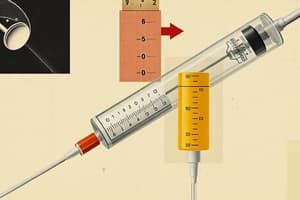Podcast
Questions and Answers
What is the dilution factor if 10 mL of sample is added to 190 mL of diluent?
What is the dilution factor if 10 mL of sample is added to 190 mL of diluent?
- 10
- 19
- 25
- 20 (correct)
How much serum is required to make a 1 to 4 dilution with a total volume of 100.0 µL?
How much serum is required to make a 1 to 4 dilution with a total volume of 100.0 µL?
- 0.025 µL
- 0.25 µL (correct)
- 25 µL
- 2.5 µL
A patient's creatinine is outside the linear range of the analyzer; 10 µL of serum is added to 90.0 µL of diluent and the diluted sample is reanalyzed. The creatinine value of the diluted sample is 1.0 mg/dL. Which of the following creatinine values is correct?
A patient's creatinine is outside the linear range of the analyzer; 10 µL of serum is added to 90.0 µL of diluent and the diluted sample is reanalyzed. The creatinine value of the diluted sample is 1.0 mg/dL. Which of the following creatinine values is correct?
- 20.0 mg/dL (correct)
- 100 mg/dL
- 1.0 mg/dL
- 10.0 mg/dL
A serum creatine kinase is diluted 1/200 with a result of 50 U/L. What is the patient's actual creatine kinase result?
A serum creatine kinase is diluted 1/200 with a result of 50 U/L. What is the patient's actual creatine kinase result?
According to CLSI, the resistivity of clinical laboratory reagent water (CLRW) must be:
According to CLSI, the resistivity of clinical laboratory reagent water (CLRW) must be:
Flashcards
Dilution Factor
Dilution Factor
The dilution factor is the ratio of the total volume of the diluted solution to the volume of the original sample.
Calculating Dilution Factor
Calculating Dilution Factor
To calculate the dilution factor, divide the total volume (sample + diluent) by the volume of the original sample.
Dilution Factor Example
Dilution Factor Example
10mL sample + 190mL diluent = 200mL total volume. Dilution factor: 200mL / 10mL = 20.
Dilution Ratio
Dilution Ratio
Signup and view all the flashcards
Serum Volume in Dilution
Serum Volume in Dilution
Signup and view all the flashcards
Calculating Serum Volume
Calculating Serum Volume
Signup and view all the flashcards
Dilution Effect
Dilution Effect
Signup and view all the flashcards
Original Concentration from Diluted
Original Concentration from Diluted
Signup and view all the flashcards
Calculating Original Creatinine
Calculating Original Creatinine
Signup and view all the flashcards
Dilution Factor - 1/200
Dilution Factor - 1/200
Signup and view all the flashcards
Calculating Actual Creatine Kinase
Calculating Actual Creatine Kinase
Signup and view all the flashcards
Clinical Laboratory Reagent Water
Clinical Laboratory Reagent Water
Signup and view all the flashcards
Resistivity
Resistivity
Signup and view all the flashcards
CLRW Resistivity Requirement
CLRW Resistivity Requirement
Signup and view all the flashcards
Ion-Exchange Filters
Ion-Exchange Filters
Signup and view all the flashcards
Anion Gap
Anion Gap
Signup and view all the flashcards
Anion Gap Components
Anion Gap Components
Signup and view all the flashcards
Plasma Osmolality
Plasma Osmolality
Signup and view all the flashcards
Calculating Plasma Osmolality
Calculating Plasma Osmolality
Signup and view all the flashcards
Ion-Selective Electrodes
Ion-Selective Electrodes
Signup and view all the flashcards
Sodium and Osmolality
Sodium and Osmolality
Signup and view all the flashcards
Henderson-Hasselbalch Equation
Henderson-Hasselbalch Equation
Signup and view all the flashcards
Blood Gas Specimen
Blood Gas Specimen
Signup and view all the flashcards
Respiratory Alkalosis
Respiratory Alkalosis
Signup and view all the flashcards
Respiratory Acidosis
Respiratory Acidosis
Signup and view all the flashcards
Metabolic Alkalosis
Metabolic Alkalosis
Signup and view all the flashcards
Metabolic Acidosis
Metabolic Acidosis
Signup and view all the flashcards
Polysaccharide
Polysaccharide
Signup and view all the flashcards
Glycolysis
Glycolysis
Signup and view all the flashcards
Insulin
Insulin
Signup and view all the flashcards
Glycogen
Glycogen
Signup and view all the flashcards
Type 1 Diabetes
Type 1 Diabetes
Signup and view all the flashcards
Type 2 Diabetes
Type 2 Diabetes
Signup and view all the flashcards
Glucose Oxidase
Glucose Oxidase
Signup and view all the flashcards
Hexokinase Method
Hexokinase Method
Signup and view all the flashcards
Cerebrospinal Fluid Glucose
Cerebrospinal Fluid Glucose
Signup and view all the flashcards
Confirmatory Test for Diabetes
Confirmatory Test for Diabetes
Signup and view all the flashcards
Study Notes
Dilution Factor Calculation
- To calculate the dilution factor, divide the total volume by the volume of the sample.
- In the example, if 10 mL of sample is added to 190 mL of diluent, the dilution factor would be 20.
Serum Dilution Calculation
- To calculate the amount of serum needed for a 1:4 dilution with a total volume of 100 µL, determine 1/5 of the total volume, which would be 20 µL.
Creatinine Correction Calculation
- A diluted sample of creatinine at 1.0 mg/dL, corrected for a 10 µL serum to 90 µL diluent ratio, shows the patient’s actual creatinine value as 10.0 mg/dL.
Serum Creatine Kinase Calculation
- To determine the patient's actual creatine kinase (CK) value, multiply the diluted result by the dilution factor, which in this case, is 1000 U/L.
Clinical Laboratory Reagent Water Resistivity
- The resistivity of clinical laboratory reagent water (CLRW) must be greater than 10 megohms/cm according to CLSI guidelines.
Ion-Exchange Filters
- Ion-exchange filters remove ions to reduce mineral content in water.
Anion Gap Calculation
- The anion gap calculation uses electrolytes like sodium, chloride, potassium along with bicarbonate (HCO3-)
Plasma Osmolality Calculation
- Plasma osmolality can be calculated using the formula Na + 2(HCO3) + Urea nitrogen - glucose.
Electrolyte Measurement
- Sodium, potassium, and chloride are routinely measured in labs using ion-selective electrodes.
Blood pH pO2, pCO2 Measurement
- Samples to measure blood pH, pO2, and pCO2 are normally heparinized venous blood.
Blood Gas Results Interpretation
- A blood gas sample with pH= 7.48, PCO2=52mmHg, HCO3 = 40 mEq/L, and pO2= 98 mmHg, suggests no deviation from normal.
Blood Gas Results (pH 7.25, dissolved CO2 = 1.8 mEq/L, HCO3-=27 mEq/L) Interpretation
- The provided blood gas parameters (pH 7.25, dissolved CO2 = 1.8 mEq/L, HCO3-=27 mEq/L) indicate metabolic acidosis.
Compensatory Response to Metabolic Acidosis
- In metabolic acidosis, the kidneys increase bicarbonate reabsorption, and the patient may breathe deeply and rapidly (hyperventilation).
Compensatory Mechanisms for Respiratory Acidosis
- In respiratory acidosis, the rate of respiration decreases (hypoventilation). Further, the kidneys increase the retention of bicarbonate to compensate.
Blood Gas Parameter:Actual Base Excess
- Actual base excess is a derived blood gas parameter.
Polysaccharide Carbohydrate
- Starch is a polysaccharide.
Glycolysis
- Glycolysis is the metabolic process of the conversion of glucose to pyruvate.
Hormone that Decreases Blood Glucose Levels
- Insulin is the only hormone that effectively decreases the levels of glucose in the blood.
Glycogen Storage Location
- Glycogen is primarily stored in the liver.
Type 1 Diabetes Characteristics
- Type 1 diabetes usually occurs early in life; it's linked to low insulin levels, ketosis, and autoantibodies to islet cells.
Type 2 Diabetes Characteristics
- Type 2 diabetes often is associated with obesity, physical inactivity, and high insulin levels.
Anion Gap Calculation (Electrolytes)
- The anion gap is calculated using sodium, chloride, potassium, and bicarbonate.
Plasma Osmolality Calculation (Formula)
- Plasma osmolality can be calculated using the formula 2(Na) + (glucose/18) + (BUN/2.8).
Electrolyte Measurement Method
- Electrolytes such as sodium, potassium, and chloride are usually measured with ion-selective electrodes.
Hexokinase Method End Product
- The actual end product measured in the hexokinase method for glucose determination is NADPH + H+, produced from the reduction of NADP.
Glucose Concentration in CSF
- The normal glucose concentration in cerebrospinal fluid is usually less than 30 mg/dL.
Glucose Tolerance Values (Diabetes Mellitus Confirmation)
- Two-hour postprandial glucose values exceeding 200 mg/dL, and fasting glucose greater than 126 mg/dL, are indicative of diabetes mellitus.
Increased Serum Total Protein, Low Albumin
- High serum total protein paired with low albumin is observed in conditions such as multiple myeloma.
Iron Deficiency Anemia Laboratory Tests
- A patient with iron deficiency anemia typically has a decreased serum iron level, a decreased transferrin saturation along with an increased total iron-binding capacity (TIBC).
Bilirubin Breakdown Product
- The breakdown product of bilirubin in the colon, oxidized by microorganisms, is urobilin.
Prehepatic Jaundice
- Congestive heart failure is a cause of prehepatic jaundice.
Unconjugated Hyperbilirubinemia Cause
- Hemolytic anemia is a common cause of unconjugated hyperbilirubinemia.
Symptoms Associated with Scurvy
- Symptoms such as loss of appetite, generalized weakness, irritability, abdominal pain, vomiting, bright red tongue, and skin rash ("Casal's necklace") suggest scurvy.
Direct Assay for Plasma Phylloquinone
- A direct assay for plasma phylloquinone measurement is primarily used to assess vitamin K status.
Indirect Methods of Vitamin Status Assessment
- Functional assays are a key method in the assessment of vitamin deficiencies.
Dietary Supplement for Rickets/Osteoporosis
- A diet with adequate vitamin D along with calcium & phosphorus is crucial for preventing Rickets in children and osteoporosis in adults.
Fluorescence Polarization Immunoassay (FPIA) Electron Spin
- In FPIA, fluorescein molecules attached to the hapten spin faster in the presence of the antigen which is a result of their interaction.
Chemiluminescent Compound
- Luminol is a chemiluminescent compound.
Microparticulate Enzyme Immunoassay Enzyme
- Alkaline Phosphatase is the primary enzyme utilized in the Microparticulate enzyme immunoassay.
Cushing's Syndrome Etiology
- Cushing's syndrome is characterized by adrenal glands producing cortisol without ACTH causing overstimulation.
Dilution Factor Calculation
- The dilution factor, when 10 mL of sample is added to 190 mL of diluent is 20.
Creatine Kinase Concentration Calculation
- A serum creatine kinase result of 50 U/L, diluted 1/200, means the actual creatine kinase concentration is 10,000 U/L.
Clinical Laboratory Reagent Water Resistivity
- According to CLSI, the resistivity of clinical laboratory reagent water must be greater than 10 megohms/cm.
Plasma Osmolality Formula
- The formula for calculating plasma osmolality is 2(Na) + (glucose/18) + (BUN/2.8).
Anion Gap Calculation (Electrolyte Group)
- The anion gap comprises the difference between sodium (Na) and the sum of chloride (Cl-) and Bicarbonate (HCO3-).
Electrolyte Measurement
- Ion-selective electrodes are commonly used to measure sodium, potassium, and chloride in laboratories.
Determining Renal Azotemia
- High protein diets can contribute to renal azotemia.
High BUN/Creatinine Ratio
- A high BUN/creatinine ratio suggests kidney dysfunction or compromised kidney function.
Primary Structure of a Protein
- The primary structure of a protein describes the linear sequence of amino acids.
Protein Nitrogen Content
- Protein contains approximately 16% nitrogen.
Iron Transport Protein
- Transferrin is the major protein responsible for transporting iron in the body.
Studying That Suits You
Use AI to generate personalized quizzes and flashcards to suit your learning preferences.





